How to Unblock a Sink
Not only is a blocked sink an inconvenience, but it is unhygienic and could cause bad odours in your home. Luckily, you can try these easy methods to unblock a sink. Last updated - 15/11/2022
Estimated reading time - 7 minutes
What has caused my sink to become blocked?
Most sink blockages are caused by the sink’s trap (the U-bend pipe under the sink) being clogged, which results in reduced or completely restricted water flow in the drain. What has clogged your sink’s trap will depend on where the sink is located. Traps in bathrooms are often clogged by a buildup of hair, toothpaste, grime, and soap scum, whereas blocked traps in kitchen sinks are mainly caused by food, cooking grease and oils, and debris.
How to unblock a sink
Hot water, baking soda and vinegar
If you have a slow drain and there is no standing water in the sink, this method could unblock a sink with minimal effort. Mixing baking soda and vinegar creates a fizzy chemical reaction that can loosen or dissolve some minor sink clogs.
How to unblock a sink using baking soda and vinegar:

- Boil some water.
- Once the water has boiled, pour it down the blocked sink.
- Immediately pour a cup of baking soda down the sink, followed by a cup of distilled vinegar.
- Put a plug in the sink and wait 10 minutes.
- the sink and run the hot water tap to flush the drain.
If this method did not work, or for more stubborn clogs, continue reading for more ways to unblock a sink.
Use a plunger
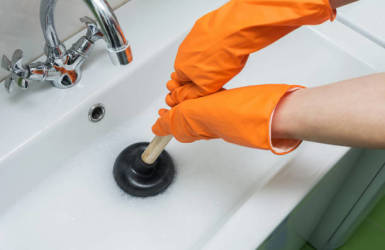
Using a plunger is probably the most popular way to unblock a sink. Plungers use suction and compression to remove clogs. When you push down on the plunger, water and the clog are forced downward, starting the process of loosening the blockage. When you pull up on the plunger, the water in the drain is pulled upward, moving the blockage in the other direction. This push-pull action loosens the clog and moves it away from the walls of the pipe, resulting in it passing through the drain.
How to unblock a sink using a plunger:
- Fill the sink with water. Fill the sink with 3 to 4 inches of water. This is to create a tight seal around the plughole. If you have a double sink, you will need to plug the other sinkhole to create enough pressure. If you don’t have a plug, you can plug it with a dishcloth or an old rag.
- Position the plunger. Don’t put the plunger straight down over the sinkhole; instead, lower it at an angle while trying to get as much water in the plunger as possible before covering the sinkhole. This is to create a tight seal and to limit getting trapped air between the plunger and the blockage, which would reduce the force of plunging.
- Start plunging. Vigorously pump the plunger up and down several times for around 20 seconds.
- Remove the plunger. After 20 seconds of plunging, pop the plunger straight off the sinkhole. If the water drains normally, then the blockage has been removed. If the water drains slowly or doesn’t drain at all, then the blockage hasn’t been cleared, so you should start the plunging process again.
- Flush the drain. If the water is now draining freely, run the hot water tap for a minute or so to flush away any remaining bits of debris.
Let us fix your plumbing.
At Smart Plan we have thousands of engineers up and down the country who are ready to fix your issue. We guarantee an engineer to your property within 48 hours.
Use a coat hanger
The purpose of using a coat hanger is to reach the obstruction and either push it down or pull it out.
How to unblock a sink using a coat hanger:
- Get a coat hanger and unwind it until it is straight.
- Bend one end of the hanger into a U shape.
- Insert the U shaped end of the hanger down the sinkhole.
- Feed the hanger through the sinkhole until you feel the blockage.
- Continuously push and pull the hanger to break up the blockage until you notice the water draining away.
- If you have pushed and pulled at the blockage for a while and haven’t noticed the water draining, pull the hanger back out. Some of the blockage might have been caught on the end of the hanger.
- If you have pulled the hanger out and the sink is still blocked, you may have helped to push the blockage down or at least broken it up a bit. You can continue this method a few more times or try the next method.
Unblock the sink trap
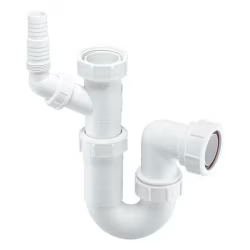
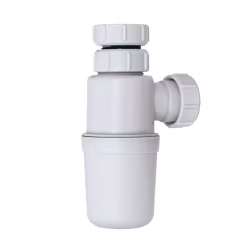
For the most stubborn obstructions, you may need to remove and unclog the sink or bottle trap. Sink and bottle traps are designed to retain a small amount of water to provide a water seal between your basin and the external drains. This helps to prevent odours, insects, and bacteria from coming back up the waste pipe and into your sink.
How to unblock a sink by clearing the waste pipe:
- Turn off the water supply. You can do this by using the mains stopcock (also known as a shut-off valve).
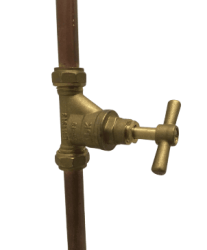
Stopcock/Shut-off valve
The most common place for the main stopcock is under the kitchen sink, but if yours isn’t located there, then it might be in your utility room, bathroom, or a cupboard underneath the stairs. - Put a plug in the sinkhole. If there is any standing water in the sink, put a plug in the sinkhole. You can drain the water after you have unblocked the trap.
- Put a bucket underneath the trap. This is to catch any standing water left in the pipe when you disconnect the sink trap.
- Disconnect the trap. To remove the trap, unscrew it at both ends. You may need to use a wrench if the trap has been tightened too much. Once you have unscrewed the trap, carefully remove it and empty the standing water into the bucket.
- Clear the blockage. Clear the trap and its connecting pipes of all obstructions. Once you have cleared the trap, take it to another basin and wash it thoroughly.
- Reattached the trap. Securely screw the trap back in place. Make sure it is screwed on tightly, or it may cause a leak.
- Flush the drain. Run the hot water tap or pour boiled water down the sink to ensure it is draining properly and to wash away any remaining debris.
How can I prevent sink blockages?
Know what can and can’t be poured down a sink
The main cause of sink blockages is food being disposed of down the sink, so always use a sinkhole strainer to catch food and debris before they get into the drainage system.
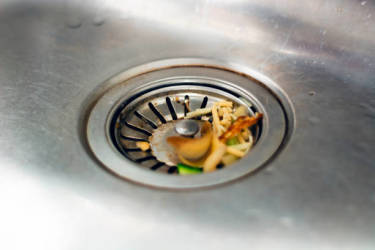
Avoid pouring cooking oil and food grease down the sink, as they could solidify and cause a blockage. Instead, pour them into a jar and put it in the bin. Don’t pour coffee grounds down the sink either. Coffee grounds don’t break up in water, instead, they clump together and can clog your drain. Instead of pouring coffee grounds down the sink, throw them in the food waste bin, or if you have a garden, throw them on your plants or grass. Coffee grounds contain minerals that help promote healthy plant growth.
Knowing how to dispose of food correctly will go a long way toward keeping your sink clog-free.
Run hot water down the drain after washing up
Run some hot water to flush away any pieces of food or grease that may have gotten through your sinkhole cover before they harden and sit at the bottom of the sink trap.
Clean your sink regularly
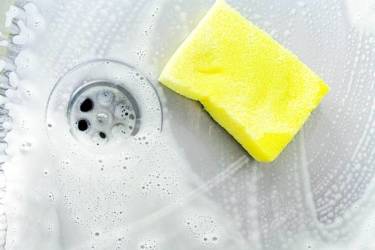
Not only will cleaning your sink regularly keep it hygienic, but it could also help loosen up and wash away items that could build up and cause a blockage. Some of the chemicals in cleaning products, bleach, washing up liquid, etc will help lubricate the pipework under your sink, which will help potential clogs flow through easier.
Address slow drains
If you notice water draining slower than usual, investigate the problem right away before a full blockage occurs. Use the methods outlined to clear partial blockages.
Avoid unexpected costs.
With a Smart Plan cover policy, you can rest easy knowing if there's an issue with your plumbing, we'll usually have you back up and running within 48 hours.
What should I do if my sink is still blocked?
If you have taken the steps outlined in this article and your sink is still blocked, then it is time to call a plumber to repair the issue. Get in touch with us today on 020 8146 3960 to help you with your home’s plumbing problems.

